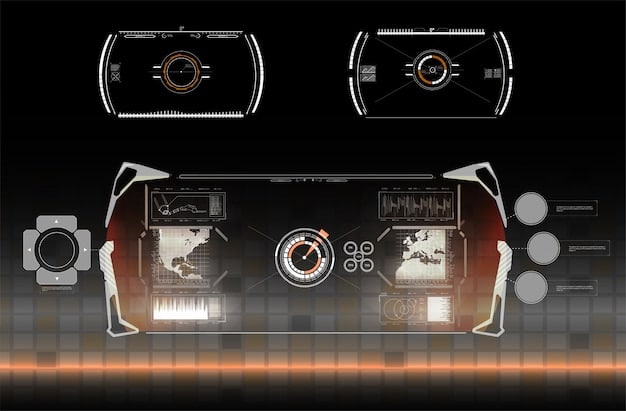Game Design Principles: Create Fun & Engaging Gameplay

Crafting compelling gameplay hinges on mastering core game design principles, a systematic approach integrating mechanics, narrative, and player psychology to ensure every interaction contributes to an immersive and enjoyable experience, moving beyond superficial aesthetics to true depth.
Ever wondered what truly sets apart a memorable game from a forgettable one? It’s not just about flashy graphics or an epic story. At its heart, creating truly fun and engaging gameplay boils down to understanding and applying fundamental Game Design Principles: Create Fun and Engaging Gameplay. This exploration delves into the core tenets that transform a mere concept into an immersive, captivating experience that keeps players coming back for more.
The Foundation: Understanding Player Experience (PX)
The cornerstone of exceptional game design lies in a deep understanding of the Player Experience (PX). This goes beyond mere aesthetics or mechanics; it encompasses the player’s emotional journey, cognitive engagement, and overall satisfaction. A great game isn’t just played; it’s felt, challenging the player in meaningful ways while providing clear pathways to mastery and enjoyment. Without a solid grasp of what motivates and delights players, even the most innovative mechanics can fall flat.
When we talk about PX, we’re considering elements like flow state, sense of accomplishment, and the feeling of agency. Achieving an optimal PX requires balancing challenge with player skill, providing clear feedback, and ensuring that every interaction feels purposeful. It’s about crafting an environment where players feel empowered, captivated, and eager to continue their journey within the digital world you’ve created.
Empathy in Design: Walking in the Player’s Shoes
At the heart of genuine player engagement is empathy. Designers must step into the player’s shoes, anticipating their thoughts, feelings, and reactions at every stage of the game. This involves more than just intuitive controls; it’s about predicting how a player will feel when facing a challenge, celebrating a victory, or encountering a narrative twist.
- 🎮 **Anticipating Frustration:** Identify potential pain points in gameplay, such as overly difficult sections or confusing objectives, and design solutions.
- 🎉 **Amplifying Joy:** Pinpoint moments of success or discovery and enhance them through clear feedback, visual cues, or audio signals.
- 🤔 **Spurring Curiosity:** Craft mysteries and unanswered questions that encourage players to explore further and invest in the game’s world.
Feedback Loops and Iteration
No game is perfect on the first try. Designing for optimal PX is an iterative process, constantly refined through feedback loops. This involves playtesting, gathering player data, and meticulously observing how players interact with the game. Each piece of feedback, whether explicit or implicit, is a valuable data point that informs subsequent design decisions. This continuous cycle of design, test, analyze, and refine is crucial for evolving a concept into a truly engaging product. The early identification of issues and adaptation of mechanics or narrative elements based on player reactions ensures that the final product resonates deeply with its audience and avoids common pitfalls that lead to player abandonment.
The goal isn’t just to fix bugs, but to systematically enhance the emotional and tactical experience, making sure that what the designer intended aligns with what the player perceives and enjoys. This process requires humility and a willingness to discard beloved ideas if they don’t serve the player experience. By prioritizing player insights throughout development, designers can create games that are not only functional but also deeply compelling, fostering a sustained connection with the audience.
Core Mechanics: The Heartbeat of Gameplay
Game mechanics are the rules and systems that define how players interact with the game world and achieve objectives. They are the verbs of your game, dictating what a player can do, how they do it, and what the consequences are. A well-designed set of core mechanics provides a clear, consistent, and intuitive framework for gameplay, forming the essential skeleton upon which all other elements are built. These mechanics should not only be fun on their own but also support the game’s core loop and overarching goals, creating a symbiotic relationship that deepens engagement.
Consider platformers, where jumping and traversing are key, or strategy games, where resource management and unit deployment are central. Each genre relies on a specific set of mechanics that are honed over time to deliver distinct experiences. The clarity and responsiveness of these mechanics directly influence player satisfaction and the ease with which they can immerse themselves in the game. When mechanics are clunky or poorly communicated, the player’s focus shifts from strategy and enjoyment to grappling with the interface and controls, severely diminishing the overall experience. Precision, responsiveness, and intuitive design become paramount in crafting mechanics that feel like a natural extension of the player’s will, enabling seamless interaction within the game world.
Defining the Core Loop
The core loop, often called the “gameplay loop,” is the repeating cycle of actions and rewards that forms the backbone of your game. It answers the fundamental question: “What does the player do, and why do they keep doing it?” A compelling core loop is addictive, providing predictable yet satisfying progression. For instance, in an RPG, the loop might be: explore -> encounter enemies -> fight -> get loot -> level up -> explore more.
- 🔄 **Simple and Clear:** The core loop should be easy to understand and instantly gratifying.
- 📈 **Progression:** Each iteration of the loop should offer some form of progress or reward.
- ♾️ **Sustainability:** The loop must be designed to be engaging over long periods without becoming repetitive.
Emergent Gameplay and Player Agency
Beyond defined mechanics, great games foster emergent gameplay – unforeseen player interactions and strategies that arise from the interplay of systems. This is where true player agency shines, allowing players to solve problems in creative, unscripted ways. Designing for emergence means creating robust systems that react dynamically to player input, rather than forcing players down a single predetermined path. This type of freedom often leads to unique player stories and extends the replayability of a game significantly. Giving players the tools to experiment and discover their own solutions not only increases engagement but also imbues the game with a sense of depth and authenticity that static, linear narratives often lack. An active community thrives on discovering and sharing these emergent properties, further strengthening the game’s longevity and appeal.
The challenge lies in designing systems that are complex enough to allow for emergent behaviors, yet simple enough for players to understand and manipulate. This delicate balance ensures that the unexpected discoveries are delightful, not frustrating. Providing a robust sandbox with flexible mechanics encourages players to push boundaries, resulting in truly unique play experiences that might even surprise the designers themselves.
Narrative and World-Building: Crafting Immersive Universes
While mechanics define how a game is played, narrative and world-building provide the context and emotional resonance that make a game truly memorable. A compelling story or a richly detailed world can transform simple actions into meaningful endeavors, captivating players and investing them emotionally in their journey. This element moves games beyond mere challenges into powerful, immersive experiences, where every choice made and every character encountered deepens the player’s connection to the virtual reality. It provides a sense of purpose and belonging, transforming the act of playing into an exploration of a vibrant, living universe.
Consider the intricate lore of a fantasy RPG or the gripping storyline of a critically acclaimed adventure game. These elements don’t just exist as background; they actively shape the player’s experience, influencing their decisions, revealing new challenges, and providing a powerful incentive for continuous engagement. A well-constructed narrative complements gameplay by adding layers of meaning and motivation, ensuring that players are not just performing actions, but living through a story. The intricate details of a game world, from its historical events to its unique cultures, invite players to delve deeper and explore the nuances that make a fictional realm feel real. It is this depth that sustains interest long after the core mechanics have been mastered, encouraging players to revisit or simply reflect upon their experiences within that world.
Storytelling through Gameplay
Games offer a unique storytelling medium where players are active participants, not just passive observers. Effective game narratives are often woven directly into the gameplay, with choices and actions having tangible consequences within the story. This creates a sense of ownership and personal investment, making the player feel like the true protagonist of their own epic. The best narrative experiences allow decisions made in gameplay to ripple through the plot, leading to multiple outcomes and increasing replay value. This interactivity elevates the narrative from a simple monologue to a dynamic dialogue between the game and the player.
Building a Cohesive World
A cohesive game world feels alive and believable, even if it’s entirely fantastical. This involves consistency in art style, environmental design, lore, and character development. Every element, from the slightest graphical detail to the most complex historical event within the game’s canon, should contribute to a unified vision, ensuring that players can immerse themselves without jarring inconsistencies. Building a truly immersive world requires meticulous attention to these details, creating a space where players can lose themselves and genuinely believe in the reality presented to them.

- 🗺️ **Environmental Storytelling:** Use the environment itself to convey backstory and current events, allowing players to discover lore naturally.
- 👤 **Authentic Characters:** Develop characters with believable motivations and arcs, making their interactions with the player more impactful.
- 📜 **Consistent Lore:** Maintain a coherent set of rules, histories, and cultures that govern the game world, reinforcing its authenticity.
Challenge and Reward Systems: Balancing Difficulty and Progression
The delicate balance between challenge and reward is fundamental to keeping players engaged. A game that is too easy quickly becomes boring, while one that is too difficult can lead to frustration and abandonment. The art of good game design involves calibrating difficulty to provide a constant, satisfying friction, ensuring that every victory feels earned and every setback provides a valuable learning opportunity. This rhythmic interplay of uphill battles and triumphant resolutions creates a compelling cycle that encourages continuous play. Effective design ensures that moments of struggle are always followed by tangible progress or enjoyable outcomes, reinforcing the player’s commitment to the game.
It’s about creating a “flow state” where players are fully immersed and challenged just enough to stay highly focused, without feeling overwhelmed or underwhelmed. This sweet spot of constructive difficulty motivates players to improve their skills and explore the game’s depths, offering a powerful sense of accomplishment with each milestone achieved. The reward system then acts as the positive reinforcement, whether it’s unlocking new abilities, gaining valuable loot, or simply advancing the narrative, each element contributing to the overall sense of progression and satisfaction. When executed effectively, this duality transforms the gameplay experience into an addictive cycle of effort and gratification, keeping players deeply invested.
The Golden Rule of Flow
Mihaly Csikszentmihalyi’s concept of “flow” is highly relevant to game design. Flow occurs when a person is fully immersed in an activity, experiencing a state of energized focus, full involvement, and enjoyment. For games, this means tailoring challenges to the player’s current skill level, gradually increasing difficulty as they improve.
- ⬆️ **Escalating Difficulty:** Challenges should naturally increase in complexity as the player gains mastery.
- 🎯 **Clear Objectives:** Players need to understand what they are trying to achieve to feel progress.
- ⚡ **Immediate Feedback:** Provide clear and timely feedback on player actions, whether successful or not.
Meaningful Rewards and Progression Systems
Rewards aren’t just about loot; they can be anything that provides positive reinforcement and a sense of progression. This could include unlocking new abilities, discovering new story elements, gaining access to new areas, or simply a surge of dopamine from overcoming a tough boss. Progression systems, like experience points and skill trees, provide visible paths for players to grow and customize their experience, offering a tangible sense of advancement. These systems tap into fundamental human desires for growth and mastery, reinforcing the time and effort players invest into the game. The varied nature of rewards ensures that different play styles and motivations are accommodated, whether a player seeks narrative progression, character optimization, or cosmetic customization. This thoughtful approach to rewards transforms simple achievements into profound markers of progress within the game’s expansive world.
By thoughtfully integrating a layered reward system, designers can cultivate sustained player engagement, promoting exploration and long-term commitment. Each reward, no matter how small, should feel earned and contribute to the player’s overall sense of purpose and accomplishment within the game. The effectiveness of these systems hinges on their ability to consistently deliver satisfaction and a clear path forward, keeping players invested in their ongoing journey.
User Interface (UI) and User Experience (UX): Seamless Interaction
The user interface (UI) and user experience (UX) are the unsung heroes of game design. A well-designed UI is intuitive and unobtrusive, fading into the background while providing all necessary information. Great UX ensures that every interaction feels natural, responsive, and free from unnecessary friction. Together, these elements enable players to focus on the gameplay itself, rather than struggling with poorly implemented controls or confusing menus. They are the invisible bridge connecting the player to the game world, ensuring that nothing stands in the way of immersion and enjoyment. Without polished UI/UX, even the most innovative mechanics can become cumbersome and frustrating, detracting significantly from the overall player experience.
When UI/UX is done right, players navigate menus, manage inventory, and execute actions almost subconsciously, allowing their full mental bandwidth to be dedicated to strategic thinking, narrative immersion, or skill execution. Conversely, a poorly designed interface can constantly pull a player out of the game’s flow, turning what should be effortless interactions into irritating obstacles. This highlights the critical role UI/UX plays not just in usability, but in directly shaping the player’s emotional engagement and long-term satisfaction. Every element, from button placement to feedback animations, must contribute to an intuitive and satisfying interaction.
Clarity and Intuition in UI Design
UI should be clear, concise, and intuitive. Players should instinctively know what elements on the screen mean and how to interact with them, without needing extensive tutorials. This involves thoughtful use of iconography, color coding, and spatial arrangement to guide the player’s eye and convey information efficiently. A clean, uncluttered interface minimizes cognitive load, allowing players to process information quickly and focus on the action. The goal is to provide just enough information to empower decisions without overwhelming the player with visual noise.
- 🎨 **Visual Hierarchy:** Use size, color, and placement to emphasize important information.
- ⚙️ **Consistent Elements:** Maintain a uniform look and behavior for recurring UI components.
- 📊 **Contextual Information:** Display information only when it’s relevant to the player’s current situation.
Responsive and Streamlined UX
User experience is about how the player feels when interacting with the game. This means ensuring controls are responsive, menus are easy to navigate, and loading times are minimized. Every action taken by the player should feel fluid and produce an immediate, comprehensible result. A streamlined UX removes barriers to enjoyment, making the game feel natural and engaging. This extends beyond basic controls to include seamless transitions between game states, clear error messages, and well-designed tutorials that onboard players smoothly without feeling patronizing. A polished UX anticipates player needs and proactively removes obstacles, making the entire journey feel effortless and enjoyable.

Furthermore, a great UX considers accessibility, ensuring that players with diverse needs can also enjoy the game. This might involve customizable control mapping, scalable text sizes, or colorblind modes. By designing with a wide range of users in mind, the game becomes more inclusive and reaches a broader audience, demonstrating a commitment to player satisfaction beyond the standard. This foresight ensures that the game’s foundational interactions are robust and adaptable, contributing positively to every player’s unique journey.
The Iterative Process: From Concept to Polished Masterpiece
Game design is rarely a straight line; it’s an iterative journey of discovery, refinement, and perpetual adjustment. From the initial concept sketch to the final polish before launch, a game undergoes countless transformations. This iterative process is driven by continuous feedback loops, playtesting, and a willingness to adapt ideas based on how players actually interact with the game. It acknowledges that even the most brilliant initial vision will evolve significantly as it moves through development, transforming in response to real-world engagement. Embracing this flexible approach is essential for creating a product that truly resonates with its audience.
Every bug fix, every rebalance, and every narrative tweak is a part of this ongoing evolution, shaping the game’s final form. The commitment to iteration means never settling for “good enough” but continually striving for excellence, informed by the very real experiences of players. This also requires a certain level of humility from designers, accepting that their initial assumptions might be challenged and that the best solutions often emerge from collective testing and feedback. Effective iteration is about building on success and learning from failures in a systematic and disciplined manner.
Prototyping and Playtesting
Prototyping involves creating rudimentary versions of game mechanics or levels to test core concepts quickly and cheaply. Playtesting, on the other hand, is the invaluable process of observing real players interacting with the game. This provides unfiltered insights into what works, what doesn’t, and where player frustration or confusion arises. Early and frequent prototyping and playtesting are crucial for identifying fundamental design flaws before they become too costly to fix.
- 📦 **Rapid Prototyping:** Build quick, disposable versions to test ideas, not perfect them.
- 👂 **Listen to Players:** Pay close attention to player feedback, even if it challenges your original vision.
- 🔍 **Observe Behavior:** Sometimes, how players act is more telling than what they say.
Refinement and Polish
Once core mechanics are solid, the focus shifts to refinement and polish. This stage involves fine-tuning controls, balancing gameplay elements, optimizing performance, and adding visual and audio flair. Polish is what elevates a good game to a great one, ensuring that every interaction feels crisp, every animation is fluid, and the overall experience is seamless and delightful. It’s the attention to detail that creates a truly professional and immersive product, making the difference between a game that is merely functional and one that truly captivates.
This meticulous phase is where the game world fully comes alive, with subtle nuances in sound design, visual effects, and environmental details contributing to a richer, more believable experience. It’s also where the game’s performance is optimized across various hardware, ensuring a smooth and consistent experience for all players. The pursuit of polish demonstrates a commitment to quality that deeply impacts player perception and ultimately, the game’s long-term success.
Future-Proofing Your Design: Adaptability and Longevity
In an ever-evolving industry, designing games that can adapt and remain relevant over time is crucial. Future-proofing involves creating flexible systems that can accommodate new content, technological advancements, and shifts in player expectations. This foresight ensures that your game isn’t just a fleeting success, but a sustainable platform capable of prolonged engagement and expansion. It’s about building a robust foundation that can evolve with the times, maintaining its appeal and capacity for innovation. This strategic approach extends the lifespan of a game, transforming it from a one-off product into a living, breathing entity that grows with its community.
The ability to integrate new features, respond to community feedback, and release meaningful updates are hallmarks of a future-proof design. This proactive stance ensures that the game continues to feel fresh and relevant, even years after its initial launch. It also provides opportunities for designers to continue expanding their creative vision, adding depth and complexity to the original experience. A flexible architecture allows for seamless updates, ensuring that players consistently receive fresh content and improved features without breaking the core experience they value.
Designing for Scalability and Expansion
Consider how your game might grow beyond its initial release. Can new mechanics be added without breaking existing systems? Is there room for new narrative arcs or multiplayer modes? Designing with scalability in mind from the outset makes future content additions far more manageable and avoids costly overhauls. This approach streamlines the development of expansions, DLCs, and live service updates, allowing the game to evolve organically. By laying this architectural groundwork, designers ensure that the game can adapt to market trends and player demands, preventing it from becoming stagnant.
Community Engagement and Live Services
For many modern games, especially those designed as live services, ongoing community engagement is paramount. This involves actively listening to players, implementing feedback, and fostering a vibrant community around your game. Regular updates, events, and clear communication channels contribute to longevity, transforming a game into an evolving experience that players can invest in for years. By building a direct relationship with the player base, developers can cultivate stronger loyalty and ensure that the game’s evolution is guided by the people who love it most. This collaborative approach not only extends a game’s lifespan but also transforms players into active participants in its continuous development.
| Key Principle | Brief Description |
|---|---|
| 🎯 Player Experience (PX) | Understanding player emotions and cognitive engagement as paramount. |
| ⚙️ Core Mechanics | Defining the fundamental rules and interactions of gameplay. |
| 📖 Narrative & World-Building | Crafting immersive stories and believable environments for players. |
| 🔁 Iterative Process | The continuous cycle of prototyping, playtesting, and refinement. |
Frequently Asked Questions about Game Design Principles
▼
The core loop is the minimal set of repeating actions and rewards that forms the continuous gameplay cycle. It’s crucial because it’s the engine that keeps players engaged, providing consistent motivation. A well-designed core loop ensures sustained interest and prolongs the game’s overall appeal. It’s the repeated gratification that maintains player retention.
▼
While often intertwined, PX encompasses the emotional and psychological journey of the player, including feelings of accomplishment, frustration, and immersion. UX, on the other hand, focuses on the usability and efficiency of the interface and interactions. UX serves PX; a good UX facilitates a positive PX, but PX extends beyond mere usability.
▼
Emergent gameplay refers to unexpected player strategies or behaviors that arise from the interaction of a game’s robust systems. Designers encourage it by creating flexible mechanics and open-ended systems that allow for multiple solutions to problems, rather than strict, linear paths. This fosters creativity and increases replayability significantly.
▼
Game development is an iterative process because it’s impossible to predict all player interactions and preferences initially. Iteration, through prototyping, playtesting, and feedback analysis, allows designers to continuously refine mechanics, narratives, and user experiences, addressing flaws and polishing elements until the game reaches its full potential, ensuring a quality release.
▼
While specific mechanics vary, core principles like designing for player experience, establishing compelling core loops, balancing challenge and reward, and ensuring clear UI/UX are universal. These principles provide a foundational framework adaptable to any genre, from action-adventure to puzzle games, ensuring engaging gameplay regardless of the specific rules or setting.
Conclusion
The journey to create fun and engaging games is less about a secret formula and more about a deep understanding of core principles. It’s about empathy for the player, meticulous attention to mechanics, compelling narrative, a balanced challenge, seamless interaction, and an unyielding commitment to iterative refinement. By weaving these game design principles into every stage of development, creators can craft experiences that resonate deeply, captivate imaginations, and stand the test of time. These aren’t just guidelines but the very scaffolding upon which truly memorable gameplay is built, fostering connections that transcend the digital realm.





